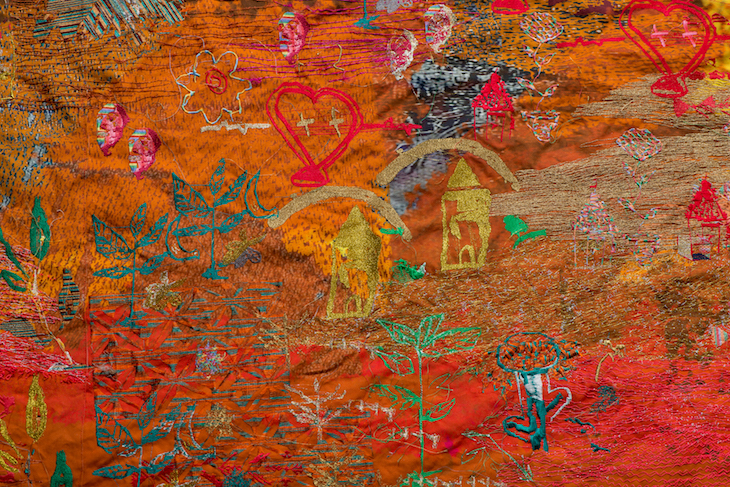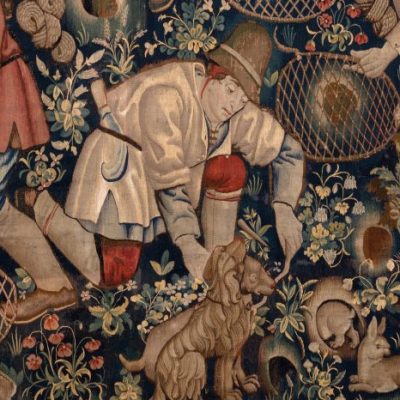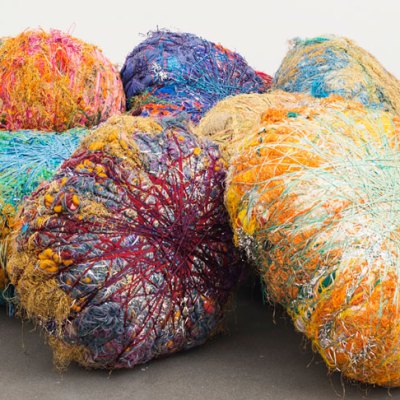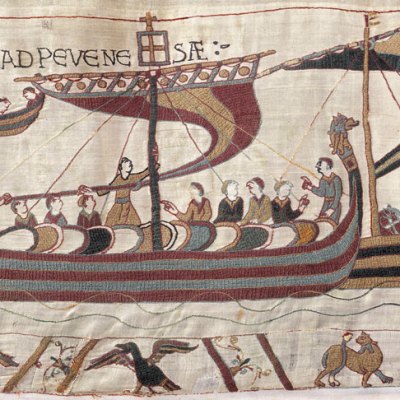Alice Kettle’s name is the only one included alongside the title ‘Thread Bearing Witness’ at the Whitworth Art Gallery, which makes sense – after all, it is her exhibition. But in reality, this is a show of thousands of names. Some of them are listed alongside Kettle’s in the wall text, some are memorialised in the works, and many are unknown but represented in the giant embroidered canvases that reflect on the experience of refugees.
Kettle is known for her large-scale textiles that combine intricate needlework with huge painterly splashes of colour. For ‘Thread Bearing Witness’, Kettle spent several years working with refugees in the UK and overseas, empowering them to express their stories through art. The resulting show at the Whitworth unites the creative endeavours of numerous refugees with the works Kettle produced in response to meeting and listening to them.
Ground – Thread Bearing Witness (detail) (2018), Alice Kettle. Photo: Joe Low

Central to the installation are three giant textiles: Sea (2017), Ground (2018) and Sky (2018). Positioned facing each other, the pieces immerse us in the various journeys made by the refugees. Kettle has recreated many paintings and drawings produced by those seeking asylum – of people, houses, flowers and birds – and stitched them into the canvases. In Ground, humans drawn by childish hands appear, reminding us of the youth of many of the migrants. The work raises troubling questions around who these figures are – are they survivors? Someone the child misses? Someone left at home? Kettle has also affixed many of the original creations to the wall nearby.
Sea – Thread Bearing Witness (detail) (2017), Alice Kettle. Photo: Joe Low; Courtesy the artist and Candida Stevens Gallery
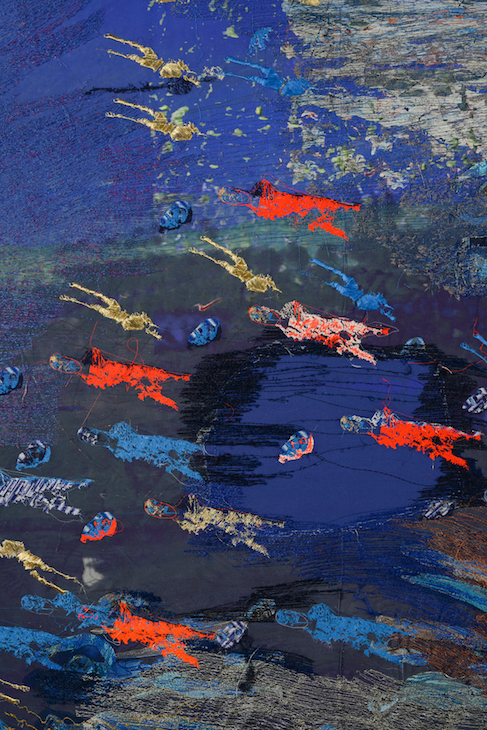
Sea is the only part of the series without artistic additions from refugees and is arguably the most harrowing. Based on press footage of migrants crossing water – often with disastrous consequences – Sea is a mass of blue tones and swirling stitches, punctuated by glowing bodies in bright orange, gold or grey. We take the position of a rescue helicopter and look down upon people scattered across the water; some are swimming, others look faded and still. Faces emerge and hands stretch out.
Sky, in contrast, is hopeful. Lighter colours blend with colourful birds and kites. Aeroplanes fly above to freedom and some birds are stitched in gold, becoming almost celestial. The faces that have appeared sporadically in the other two works now line up along the bottom of the fabric, looking up to the sky, to the future. Behind Sky, a hot air balloon emerges in a very similar print to the textile, appearing to literally lift the installation into the air.
Sky – Thread Bearing Witness (detail) (2018), Alice Kettle. Photo: Joe Low; Courtesy the artist and Candida Stevens Gallery

Thickly embroidered arrows frame Ground and Sea. All pointing in the same direction, the arrows are reminiscent of weather reports detailing wind direction. They do not refer to wind here, rather the direction of people away from danger towards safety. By the time we reach Sky the arrows have lost their distinct form and transform into thin thread trails that point all over the place. There is no clear direction; possibilities are endless.
Sea – Thread Bearing Witness (detail) (2017), Alice Kettle. Photo: Joe Low; Courtesy the artist and Candida Stevens Gallery
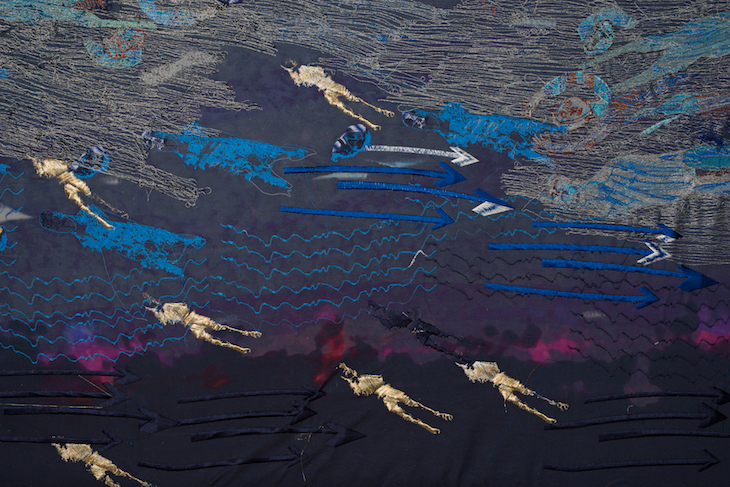
The works are flanked by art produced in collaboration with other artists and organisations. Stitch a Tree (2017–18) covers nearly the entire width of the gallery with 3,000 hand-stitched trees produced all over the world in support of refugees. Close up, each embroidery looks different and yet together they represent a huge community of people with a common language and a desire to stand with asylum seekers. Meanwhile, textile sculptures made by displaced female artists in conjunction with the Travelling Heritage Bureau are dotted around the space. The women selected artworks that they’d previously produced in a variety of media – ranging from photography to painting – to be printed on to fabric and then reconfigured as soft, cushion shapes. Frustratingly, information about both the textile sculptures and the Stitch a Tree project is lacking in the gallery. Without contextualisation these works lose their resonance and fade into the background as pretty but slightly baffling textiles.
Installation view of Stitch a Tree, part of ‘Alice Kettle: Thread Bearing Witness’ at the Whitworth Art Gallery, Manchester. Photo: Michael Pollard

What all of these works do wonderfully, though, is express the power of creativity in dealing with trauma and creating community. ‘Thread Bearing Witness’ doesn’t just tell a detached story of refugee plight, but allows the migrants to narrate their experiences in the first person and to express something of the journey they continue to endure. As Kettle writes in the accompanying catalogue, ‘at the core of the project has been a willingness to be guided by refugees’. There is no doubt that in being guided in this way, Kettle has created an exhibition that gives individual refugees a voice within the wider context of the migrant crisis.
Stitch A Tree (detail) (2017–18), contributions from various individuals from across the world. Photo: Joe Law
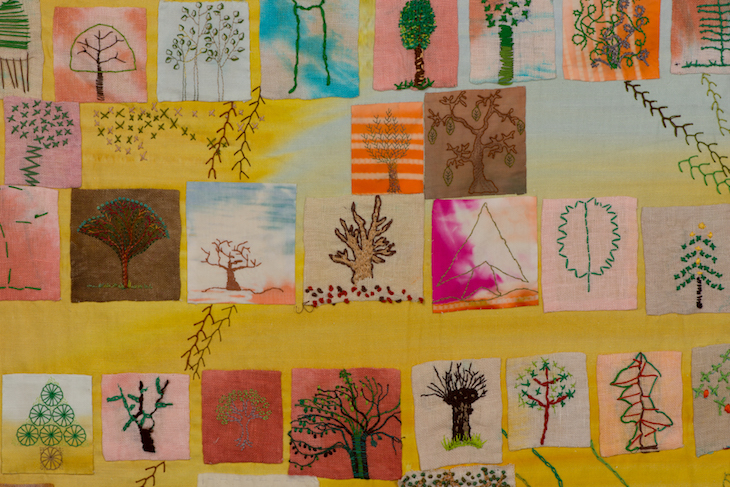
‘Alice Kettle: Thread Bearing Witness’ is at the Whitworth Art Gallery, Manchester, until 24 February 2019.
